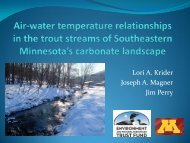Minnesota Water Resources Conference - Water Resources Center ...
Minnesota Water Resources Conference - Water Resources Center ...
Minnesota Water Resources Conference - Water Resources Center ...
You also want an ePaper? Increase the reach of your titles
YUMPU automatically turns print PDFs into web optimized ePapers that Google loves.
BOOK OF ABSTRACTS<br />
Tuesday, Monday, October 27 23<br />
Poster Session 4:45–5:45<br />
Highway 36 Reconstruction: Erosion Control is a Collaborative Effort<br />
Nicole Daneilson-Bartelt, Mn/DOT, nicole.danielson-bartelt@dot.state.mn.us; Paige Wein, Ramsey-Washington Metro<br />
<strong>Water</strong>shed District; Mike Goodnature, Ramsey County Soil and <strong>Water</strong> Conservation District; Dwayne Stenlund, <strong>Minnesota</strong><br />
Department of Transportation<br />
The Highway 36 Reconstruction in North St. Paul is a project recognized for having a number of innovative<br />
construction and contracting techniques including total closure of the road during construction, intelligent<br />
compaction, and machine control, among others. Due to these innovations, the project was watched and<br />
visited regularly by many interested parties. All aspects of the project were open to increased examination,<br />
including erosion control.<br />
The objectives of the Highway 36 erosion control plan were to follow the Stormwater Pollution Prevention Plan<br />
(SWPPP) in a timely and appropriate manner, use available materials and labor to protect natural resources<br />
onsite, and communicate effectively between all erosion control partners.<br />
The methods used to meet the goals of the erosion control plan focused on the “team effort” between the<br />
erosion control partners. The following are some of the tools used to keep all parties informed of important<br />
issues: regular on-site meetings, preemptive notification if there were any erosion control issues and how they<br />
were being addressed, follow-up after any incidents, documentation of issues, solutions, and all regular best<br />
management practices (BMP). The contractor and project partners also worked together to identify unique<br />
best management practices, such as use of slash mulch for tracking control and washout pits, and a floating silt<br />
curtain as a last outfall protection for the season.<br />
The Highway 36 Reconstruction Team was recognized for the efforts of all partners with respect to<br />
environmental excellence. Communication and cooperation were the keys to addressing erosion and<br />
sedimentation control issues and maintaining good rapport between all interested parties.<br />
Linking Submerged Aquatic Vegetation Restoration to the TMDL for the Upper Mississippi River-Lake<br />
Pepin System<br />
Joseph DePinto, Limno Tech Inc., jdepinto@limno.com; Wendy Larson, Limno Tech Inc.; Dan Rucinski, Limno Tech Inc.; Todd<br />
Redder, Limno Tech Inc.; Norman Senjem, <strong>Minnesota</strong> Pollution Control Agency; Hafiz Munir, <strong>Minnesota</strong> Pollution Control<br />
Agency<br />
The State of <strong>Minnesota</strong> is developing a TMDL for a 90 mile section of the Upper Mississippi River that is driven<br />
by 303(d) priority listings for both turbidity and nutrient enrichment (total phosphorus and chlorophyll a). In<br />
addition to the turbidity and nutrient enrichment water quality concerns, the frequency of submerged aquatic<br />
vegetation (SAV) in the shallow and backwater areas of the system in 2002 is well below what was observed at<br />
the start of the USGS Long Term Monitoring Program (LTRMP) in 1991. We have developed a GIS-based model<br />
that computes SAV biomass production on a spatially distributed basis for Vallisneria americana (Wild Celery)<br />
and Potamogeton pectinatus (Sago Pondweed) based on USACE-ERDC models for these two species. It has been<br />
calibrated to lower Pool 4 aquatic vegetation data from the LTRMP, and then applied to three different areas in<br />
Pool 2, Pool 3, and upper Pool 4. The model results demonstrate how reduction of turbidity and phytoplankton<br />
biomass as a function of TMDL implementation will increase light penetration, thus creating an environment<br />
that is more conducive to increased SAV growth and areal coverage.<br />
37 <strong>Minnesota</strong> <strong>Water</strong> <strong>Resources</strong> <strong>Conference</strong>, October 27–28, 2008
















